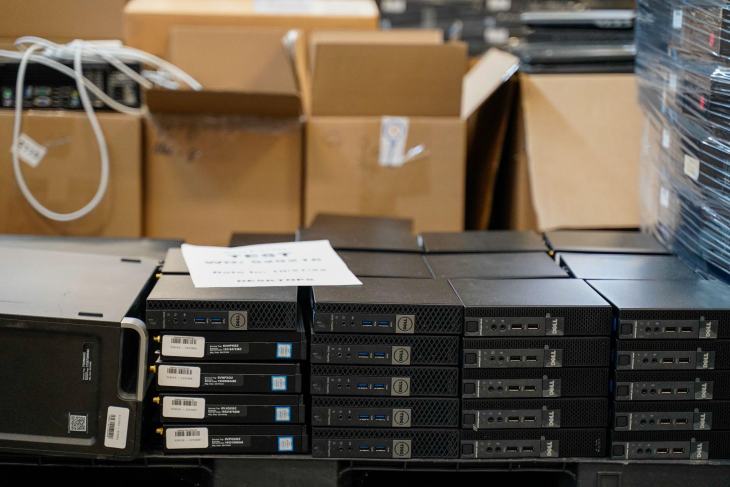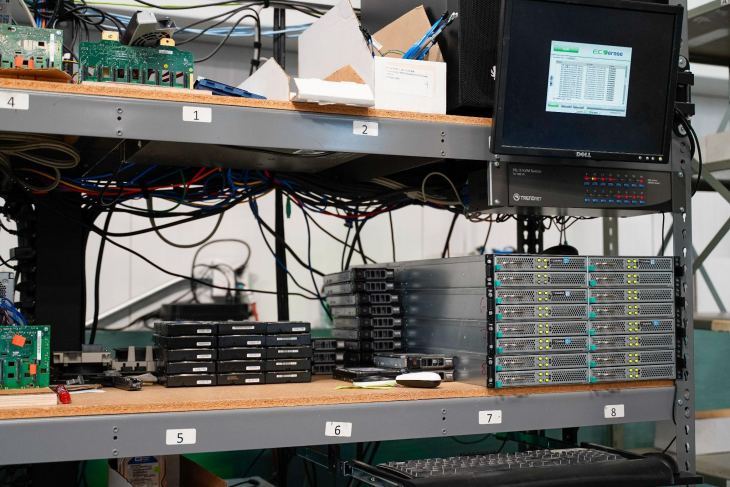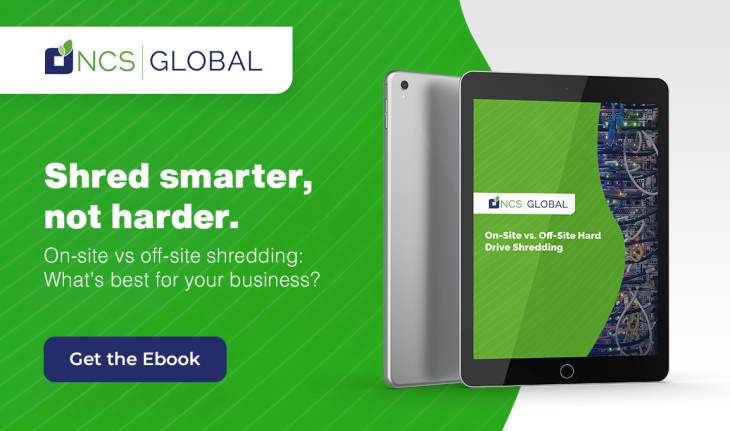Secure Data Destruction: Safeguarding Your Business and Compliance

Key Takeaways
- Proper Data Destruction is Critical for Security and Compliance. Inadequate data destruction can lead to severe consequences, including hefty fines, lawsuits, and reputational damage.
- Multiple Methods Exist for Secure Data Destruction. Organizations can choose from various techniques including data wiping, degaussing, and physical destruction, with each method having advantages.
- Certified ITAD Providers Are Essential Partners Working with certified IT Asset Disposition (ITAD) providers ensures compliance with industry standards and regulations while providing documented proof of proper data destruction through Certificates of Destruction (CoD).
Secure data destruction is the process of safely and permanently erasing data from storage devices to ensure it cannot be recovered or misused.
Imagine that a member of your IT team has been asked to clear out a closet full of old laptops, desktop machines, and miscellaneous mobile devices. He contacts a local junk removal company to pick them up and haul them away. Unbeknownst to you, that company posts them to an online auction site and offers them for sale to the highest bidder. But there’s a problem: no one ever wiped the hard drives on those devices. Some of them may contain sensitive customer or employee information, or could provide hackers with clues about your company’s network security.
That’s exactly what happened to financial services giant Morgan Stanley. As a result of their negligence, the firm paid $60 million in fines, faced multiple lawsuits, and was the subject of some very bad publicity.
By engaging a reputable IT asset disposition (ITAD) company, you can prevent this kind of sensitive information from falling into the wrong hands. Secure data destruction involves specialized methods and technologies to overwrite, degauss, or physically destroy storage media, ensuring that data is irretrievably eliminated.

The Risks of Inadequate Data Destruction
Growing concerns about data breaches, identity theft, and regulatory compliance have made secure data destruction more important than ever. Regulators are scrutinizing data security and privacy, strengthening laws like GDPR, HIPAA, GLBA, and CCPA with strict penalties for organizations that fail to take appropriate measures to protect data.
Failing to securely destroy data can have severe consequences, including compliance penalties, lawsuits, lost revenue, and serious reputational damage. There may also be direct costs associated with breach response, and the resulting loss of customer trust can have long-term effects on an organization’s market position.
Real-world incidents like the Morgan Stanley case underscore the vital importance of secure data destruction. There are numerous other examples, though, of what can happen if an organization fails to diligently address data security. A California health plan was fined over $1.2 million, for instance, when they returned a fleet of leased copiers to the lessor without destroying the data stored on those devices’ hard drives. This illustrates that very often, organizations may not even be aware that their retired IT equipment contains confidential data. Reputable ITAD companies understand the secure data destruction process and can protect companies against these kinds of oversights.
Methods of Secure Data Destruction
There are several common methods for secure data destruction. Each has its unique advantages. Here are some of the most popular techniques:
· Data wiping involves systematically overwriting the data on a hard drive with random patterns of ones and zeros, ensuring that the original information is rendered irretrievable. This allows the storage media to be reused, which is beneficial to the environment and can yield revenue from the sale of used devices. Data wiping is sometimes referred to as “secure erasure.”
· Degaussing is a process that destroys data on magnetic media by exposing media such as hard drives or tapes to strong magnetic fields. This renders the data unreadable, but it typically makes the storage device unusable as well. Degaussing is highly effective and fast, but it requires specialized equipment and is limited to magnetic media.
· Physical destruction involves shredding or crushing storage media. This approach is sometimes preferred where a very high standard for data security is required, such as in defense contracting or financial services. Naturally, physical destruction does not allow for the reuse of a storage device.
· Incineration and other methods are less common but may be used in ultra-high security environments. Incineration involves burning the storage media, reducing it to ash, and eliminating even the remotest possibility of data recovery. These methods can be very costly, require specialized facilities, and can be hazardous to the environment.
Each of these secure data destruction methods has its pros and cons. Data wiping is appropriate to most use cases because it is highly secure and allows for the reuse of media. Hard drive shredding is also very common, especially for organizations with extremely high security standards. The choice of method typically depends on the sensitivity of the data, the need for reuse, environmental considerations, and cost.

Compliance and Legal Considerations
Secure data destruction is driven by a combination of industry-specific standards and general data protection regulations. For example, in healthcare, HIPAA mandates the proper disposal of protected health information (PHI), while the financial sector adheres to the Gramm-Leach-Bliley Act (GLBA) and Payment Card Industry Data Security Standard (PCI DSS) for securely destroying customer financial data. Regulations like the GDPR and CCPA impact virtually everyone, imposing strict guidelines for the handling of personal data. Compliance with these regulations is becoming increasingly important, as regulators around the world intensify their scrutiny of data privacy practices.
To demonstrate compliance, companies should maintain thorough records documenting the chain of custody and data destruction records for their retired IT equipment. A disciplined process ensures that every stage of secure data destruction is tracked and traced, offering full transparency.
Benefits of Partnering with a Certified ITAD Provider
By working with a certified ITAD service provider, companies can ensure that they are in full compliance with best practices in secure data destruction. These companies have specialized expertise that can often mean the difference between success and failure. Certified ITAD providers are well-versed in industry standards, regulations, and best practices, so they can help organizations to avoid the high costs and reputational damage that result from a data breach.
It’s especially important to look for organizations with recognized industry certifications like e-Stewards, which indicates that an ITAD provider adheres to the highest standards in both data security and environmental responsibility. The e-Stewards certification mandates strict protocols for securely destroying data and responsibly managing electronic waste. Certified ITAD companies maintain clear records, enabling their customers to verify that data has been securely and irreversibly destroyed. A Certificate of Destruction (CoD) from a reputable ITAD provider, for example, offers evidence that your organization has followed best practices in secure data destruction.
Best Practices for Secure Data Destruction
Secure data destruction is a well-defined discipline, with an established body of best practices. Here are some actionable steps to ensure you are adequately protecting your organization and its stakeholders:
· Conduct regular audits of your organization’s data destruction processes, ensuring that outdated or unnecessary data is properly identified and disposed of. Ask your ITAD provider for reports and CoDs.
· Train your employees to understand the risks of improperly disposing of IT devices. Educate them about the importance of secure data destruction protocols.
· Select the best data destruction method for your organization based on the sensitivity of your data, the type of storage media, cost, and your organization’s sustainability goals.
Integrating secure data destruction into the broader IT asset management and lifecycle management processes is vital for maintaining a cohesive approach to data security. This ensures that data destruction is not an afterthought, but rather is a key component of asset management from acquisition to disposal. Develop a data destruction policy and update it periodically to align with evolving threats and regulations.
Conclusion
In a world where digital security is vital, secure data destruction is an essential practice for every organization. It helps you protect your business, maintain customer trust, and ensure compliance with data privacy and security regulations. By partnering with a certified ITAD provider and implementing industry-recognized methods, you can safeguard sensitive information, mitigate risks, and avoid costly penalties. Don’t let your business become the next cautionary tale; make secure data destruction an integral part of your IT asset management strategy. Talk to an expert at NCS Global today.
